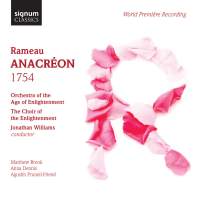Texte paru dans: / Appeared in: |
|
|
Outil de traduction ~ (Très approximatif) |
|
|
Reviewer: Barry
Brenesal 1753 was not a good year for Rameau. His pastorale Daphnis et Eglé, intended for Fontainebleau, was called off at the last minute because the dress rehearsal proved a disaster. (The composer also made a life-long enemy of its librettist, Charles Collé, supposedly out of his many demands for rewrites.) Rameau’s next pastorale, Lysis et Délie, was withdrawn before its first performance after criticisms that it was too much like Daphnis et Eglé, while his acte de ballet, Les Sibarites, proved no great success either in its original form or as a subsequent part of the opéra-ballet, Les surprises de l’Amour. (Les surprises had not yet arrived at its final version, but this one did achieve the rare distinction of making Louis XV yawn in public.) Rameau broke as well with his powerful, long-time patron, La Pouplinière, of which the most immediate effect was the withdrawal of protection that kept some of his more scurrilously vocal opponents at bay. The following year didn’t start off any better. The composer decided to scrap an opéra-ballet he’d been working on with his frequent librettist, Louis de Cahusac, called Les beaux jours de l’Amour. He instead saved and partially rewrote its two completed acts, La naissance d’Osiris and Anacréon, for performance as discrete works. The problems of 1753 came back to haunt the latter: Louis-Marie-Augustin, Duke d’Aumont, who oversaw all the King’s meals and entertainment, commanded the holding of two extra rehearsals to attend and assess whether Anacréon would prove proper fare for His Majesty, in light of the failures of Daphnis et Eglé and Lysis et Délie. One can imagine how the elderly, vastly experienced, thin-skinned Rameau reacted to being treated like a novice. The work was in any case a great success, though Charles, Duke de Luynes, whose tastes ran to the composer’s earlier, grander manner, singled out two major things he especially disliked: “This is not Rameau anymore, but this is still Cahusac.” I’ve written several times previously of Matthew Brook. He strikes me as one of the finest operatic basses of today, for his amply dark tone, broad range, interpretative skill, forward enunciation, and unassailable skill with figures. I’ve never heard him in the French Baroque repertoire, however, and here he manages such airs as the very different “Comme une fleur” and “Des caprices du sort” (one of the gems of the score) with a fine, light manner. His Anacréon leads me to hope that some of the fine French conductors of Baroque opera recordings will not consider it unpatriotic to add him to their future casts. Anna Dennis has struck me in the past as an attractively mezzo-shaded soprano with good focus, who softened her consonants in her upper range, and whose figurations became sketchy in faster passages. The part of Chloé plays into her strengths, with the slow, melancholy “Tendre Amour!” one of the standouts in this recording, both for its shaping of phrase and beautiful tonal emission. The figures in her moderately paced “L’Amour, riant et sans bandeau” pose no problems she can’t solve, while its central section again gives her a chance to show off her tonal resources once more. The cast is completed by high tenor Agustin Prunell-Friend. My reactions to his art have changed over the years. In a review of Terradellas’s Artaserse (RCOC 800) recorded in 2008 I praised his “accuracy, good, clean runs and fine breath support” as compensation for his “rather hard tone,” but his performance in Caldara’s Il più bel nome (Glossa 920310) a year later found “every note is now aspirated, and pitch is not always on center.” He remains as ever a stylishly sensitive and intelligent artist on this recording, and neither pitch nor aspiration are issues any longer, but there’s now more than a hint of a beat on several occasions in his voice, an unpleasant broadening of some vowels throughout, and an apparent reluctance to perform figures. Jonathan
Williams conducts the Age of Enlightenment forces with vigor, warmth, and
great attention to rhythmic values. His orchestra seems dull and moderately
recessed from the microphone in such pieces as the “pantomime pour Silène,”
the pair of tambourins, and the “air pour les jeunes Théoniennes,” diluting
the vividness of both performance and score. As the vocal soloists are all
miked well, I’m led to wonder whether the same microphone arrangement used
for the vocal pieces wasn’t perhaps employed as well for work’s numerous
dances. In any case, it is unfortunate given the sheer imagination Rameau
poured into them, though no more likely to wreck one’s pleasure than Prunell-Friend’s
acidic Batile. This Anacréon (the composer actually wrote another opera by
the same name, though to a completely different libretto and with entirely
different music) is nowhere else available, so its recording fills an
important niche. It’s also a vibrant score, exuberantly conducted, and with
two excellent performances. The disc is definitely short on timing, but
fanciers of French Baroque opera, and especially Rameau, will want this. | |
|
|
|
|
Cliquez l'un ou l'autre
bouton pour découvrir bien d'autres critiques de CD |
|




